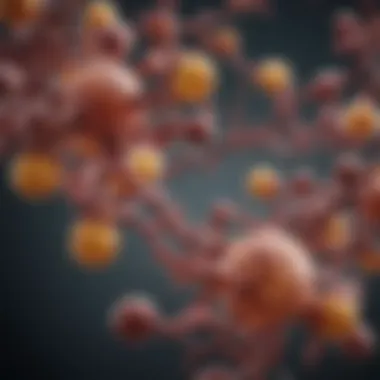Upadacitinib: Understanding Its Mechanism of Action


Intro
Upadacitinib is known as a selective Janus kinase (JAK) inhibitor, specifically targeting JAK1. Its primary purpose is in the treatment of autoimmune diseases. Understanding its mechanism of action is crucial, given the complexity of immune regulation. JAK pathways are integral to cellular signaling and immune response.
This section provides an overview of recent advancements in this area, detailing new findings, technological innovations, and the implications for medical practice.
Recent Advances
Latest Discoveries
Recent studies revealed significant insights into how upadacitinib interacts with the immune system. Clinical trials showed notable improvements in patients with conditions like rheumatoid arthritis and atopic dermatitis. Researchers have observed that upadacitinib effectively inhibits JAK1, which in turn reduces cytokine signaling. This action leads to a decrease in inflammation and immune overactivity, benefitting the quality of life for many patients.
Moreover, meta-analyses indicate a favorable safety profile, highlighting its efficacy compared to traditional therapies. More longitudinal studies are ongoing, seeking to gather more data on long-term effects and benefits.
Technological Innovations
Advancements in technology have played a critical role in the developmental phase of upadacitinib. For instance, high-throughput screening techniques enabled rapid identification of JAK inhibition properties. Structural biology methods have offered insights into the binding effects of upadacitinib with JAK1, revealing its selectivity over other isoforms. This selectivity is essential in minimizing side effects often seen with broader kinase inhibitors.
"Understanding the structure and function of upadacitinib offers a pathway for further advancements in autoimmune therapies, particularly in personalized medicine."
Methodology
Research Design
Research on upadacitinib predominantly follows a randomized, controlled trial design. This method is often employed to assess the drug's effectiveness against placebo and existing treatments. Such designs help in determining the efficacy and safety profile of upadacitinib in clinical settings.
Data Collection Techniques
Data collection for studies involving upadacitinib includes both qualitative and quantitative approaches. Researchers gather clinical data through various methods such as:
- Patient-reported outcomes
- Laboratory assessments
- Imaging studies
- Longitudinal follow-ups
These comprehensive data collection techniques contribute to a holistic understanding of the drug's performance.
In summary, the journey of upadacitinib from laboratory to clinic has seen impressive recent advances. These advances provide valuable insights into its mechanism of action, making it a relevant topic for ongoing research and application in the medical field.
Prologue to Upadacitinib
In recent years, the study of targeted therapies for autoimmune diseases has gathered significant attention. Upadacitinib emerges as a pivotal player in this landscape, particularly as a selective Janus kinase (JAK) inhibitor. This section is critical for understanding how this drug fits into current treatment strategies and offers benefits for patients.
By focusing on Upadacitinib, we can dissect its unique properties and advantages when compared to traditional therapies. Understanding the drug's mechanism, applications, and clinical data will illuminate the exciting potential it holds for managing conditions like rheumatoid arthritis, psoriatic arthritis, and ulcerative colitis. This is essential not only for healthcare professionals but also for researchers and educators who delve into new treatments in immunology.
Overview of Upadacitinib
Upadacitinib is an oral medication specifically developed to inhibit certain JAK enzymes. JAK enzymes play a vital role in the signaling pathways that govern the immune response. By selectively targeting these enzymes, Upadacitinib modulates inflammatory processes at a cellular level. Its pharmacokinetic profile allows for effective and convenient dosing, making it a practical option for both practitioners and patients.
Clinical Applications
The clinical range of Upadacitinib is both impressive and varied. It provides a new option for individuals suffering from different autoimmune disorders. The following subsections will explore its application in three major conditions: rheumatoid arthritis, psoriatic arthritis, and ulcerative colitis.
Rheumatoid Arthritis


Rheumatoid arthritis is a chronic inflammatory disorder that significantly impacts joints and other systems in the body. The drug has gained favor in this area due to its ability to reduce both the symptoms and progression of the disease.
A key characteristic of rheumatoid arthritis is the persistent inflammation of joints, leading to pain and disability. Upadacitinib's capability to inhibit JAK enzymes directly correlates with reduced levels of inflammation. This is crucial as it helps manage the disease's debilitating effects. The unique feature of Upadacitinib in this scenario is its swift onset of action, which differentiates it from many other treatments. However, its impact on immune suppression requires continuous monitoring.
Psoriatic Arthritis
Psoriatic arthritis is another autoimmune condition where Upadacitinib has shown promise. This disorder combines joint inflammation with skin psoriasis. One of the noteworthy aspects of its application here is its dual-action, addressing both skin and joint symptoms.
The ability to target both manifestations makes Upadacitinib a beneficial choice for treating psoriatic arthritis. It provides a targeted approach that not only reduces joint pain but also improves the skin condition. This dual advantage can enhance the overall quality of life for patients. Nevertheless, the potential adverse effects could necessitate a more cautious approach when used in certain populations.
Ulcerative Colitis
Ulcerative colitis is a chronic condition that leads to inflammation in the digestive tract. Treatment options have traditionally been limited, making Upadacitinib an important addition to the therapeutic arsenal.
The key characteristic of ulcerative colitis is its unpredictable flare-ups, which can significantly disrupt daily life. Upadacitinib aims to maintain remission and provide stability for sufferers. Its unique mechanism of action aligns well with the need to control inflammation in the gut, making it a popular consideration in treatment protocols. However, potential side effects, such as gastrointestinal discomfort or increased susceptibility to infections, must be carefully considered by healthcare providers.
The Role of Janus Kinases
Janus kinases, commonly referred to as JAKs, play a crucial role in the signaling pathways related to the immune system. These enzymes facilitate communication between cell surface receptors and intracellular signaling pathways. In this context, understanding JAKs paves the way for appreciating how upadacitinib exerts its therapeutic effects in autoimmune diseases. By inhibiting specific JAKs, the drug can modulate the inflammatory response that is often dysregulated in conditions like rheumatoid arthritis, psoriatic arthritis, and ulcerative colitis.
The importance of JAKs lies in their involvement in the JAK-STAT signaling pathway. They are activated in response to various cytokines and growth factors. When activated, JAKs phosphorylate specific transcription factors, thus allowing them to enter the nucleus and affect gene expression. This mechanism essentially dictates how cells respond to inflammation and immune challenges.
Understanding JAK Enzymes
JAKs consist of four main members: JAK1, JAK2, JAK3, and TYK2. Each of these JAK enzymes has distinct roles in different biological processes.
- JAK1: Primarily associated with the signaling of various cytokines, influencing immune responses.
- JAK2: Key player in hematopoiesis and interferon signaling.
- JAK3: Primarily expressed in lymphocytes and plays a significant role in immune signaling.
- TYK2: Involved in the signaling of type I interferons and interleukin-12.
Inhibiting these enzymes can specifically hinder excessive inflammatory responses, a hallmark of many autoimmune conditions.
JAK-STAT Pathway Overview
The JAK-STAT pathway is a fundamental cellular mechanism that translates external signals into cellular responses. This pathway begins when a cytokine binds to its receptor on the cell surface, activating the associated JAK. The activated JAK then phosphorylates tyrosine residues on the receptor, creating docking sites for STAT proteins.
Once recruited, STAT proteins are themselves phosphorylated by JAKs, leading to their dimerization and subsequent translocation into the nucleus. Here, they bind to specific DNA sequences, regulating the expression of target genes involved in the immune response.
"The JAK-STAT pathway is essential for mediating responses to cytokines, playing a pivotal role in both adaptive and innate immunity."
By understanding this pathway, one can appreciate how upadacitinib's mechanism of action ties back to the inhibition of JAK enzymes. This inhibition ultimately leads to altered gene expression and a reduction in the inflammatory processes typical of autoimmune disorders.
Mechanism of Action of Upadacitinib
In understanding the mechanism of action of upadacitinib, one must consider its significant role in treating autoimmune diseases through selective inhibition of Janus kinase (JAK) enzymes. This mechanism is crucial for comprehending both the therapeutic benefits and the potential implications of the drug. Upadacitinib's action primarily revolves around modulating immune response, thus offering relief from conditions characterized by inappropriate or excessive inflammation.
Inhibition of JAK Enzymes
Upadacitinib exhibits its effects primarily by inhibiting JAK enzymes, particularly JAK1. These enzymes play a vital role in the signaling pathways that transmit information from various cytokines, leading to immune responses. The inhibition of these enzymes directly alters the process of gene transcription that follows cytokine receptor activation. By blocking JAK1, upadacitinib effectively disrupts the cascade of inflammatory signals typically associated with autoimmune diseases.
This selective inhibition allows for a more targeted intervention, differentiating it from other broader immunosuppressive therapies. Healthcare professionals often note that this specificity leads to a more favorable side effect profile, as less off-target kinase activity reduces unwanted immunosuppression.
Impact on Cytokine Signaling
The impact of upadacitinib on cytokine signaling is profound. It leads to a notable reduction in pro-inflammatory cytokines, which are crucial players in autoimmune disease progression.


Reduction of Pro-inflammatory Cytokines
The specific reduction of pro-inflammatory cytokines, such as interleukin-6 and tumor necrosis factor-alpha, is essential in controlling inflammation. This effect can alleviate symptoms and prevent further tissue damage in diseases like rheumatoid arthritis and ulcerative colitis. The key characteristic of this reduction is its targeted approach. Unlike traditional corticosteroids that broadly suppress immune function, upadacitinib's focused mechanism minimizes collateral immune suppression, making it a beneficial choice for maintaining immune defense while treating inflammation.
Moreover, the unique feature of this reduction is its rapid onset. Clinically, patients report improvements in their symptoms within weeks of initiating treatment, which has made upadacitinib an attractive option among physicians and patients alike.
Influence on Immune Cell Function
Beyond cytokine levels, upadacitinib significantly influences immune cell function. By altering JAK-mediated signaling, it affects the activity and proliferation of various immune cells, including T cells and B cells. This modulation contributes to the overall therapeutic effect observed in autoimmune diseases.
The key characteristic of influencing immune cell function through upadacitinib is its differential effects on immune cell types. For instance, while it is effective in dampening the activity of activated T cells, it seems to preserve the functionality of regulatory T cells. This selective regulation is a popular aspect of its action, as it aims to achieve a balance in immune response without completely shutting down the immune system.
However, one should consider the potential drawback. While reduced activity of certain pro-inflammatory cells may lead to symptom relief, it is vital to monitor long-term immune responses. A careful balance must be maintained to avoid increased susceptibility to infections.
Effects on Cell Signaling Pathways
The overall effects of upadacitinib on cell signaling pathways represent another essential aspect of its mechanism of action. By modulating these pathways, upadacitinib plays a role in various cellular processes that contribute to cellular health and disease progression. This modulation can impact not only inflammation but also tissue repair and regeneration processes.
In summary, the mechanism of action of upadacitinib is multi-faceted, with selective inhibition of JAK enzymes leading to significant changes in cytokine signaling and immune cell function. As research continues, understanding these intricate mechanisms will help refine therapeutic strategies and improve patient outcomes.
Comparison with Other JAK Inhibitors
The analysis of upadacitinib does not stand alone; a comprehensive understanding of this selective JAK inhibitor also involves comparing it with other JAK inhibitors on the market. This comparison is crucial as it provides insights into the similarities and differences in mechanisms of action, efficacy, and safety profiles among drugs in this category. By understanding these factors, clinicians and researchers can make more informed decisions regarding treatment options for autoimmune diseases.
Upadacitinib is not the only player in the JAK inhibition space. Other well-known JAK inhibitors include tofacitinib and baricitinib. Each of these has distinct characteristics that warrant careful consideration when selecting a treatment plan. The purpose of this section is to dissect the mechanisms of action significant to these drugs while examining their effectiveness and safety for patients.
Mechanisms of Other JAK Inhibitors
Tofacinib and baricitinib, like upadacitinib, target the JAK family of enzymes, but they do so in different ways. Tofacitinib primarily inhibits JAK1 and JAK3 enzymes, influencing the signaling pathways of various immune responses. This can lead to a broader anti-inflammatory effect, beneficial in treating conditions such as rheumatoid arthritis and ulcerative colitis.
Baricitinib has a different target profile. It inhibits JAK1 and JAK2, affecting hematopoiesis and immune response. Because of these differences, the drugs might demonstrate unique clinical outcomes in terms of efficacy and side effects. Understanding these nuances is essential for healthcare professionals to rationalize which JAK inhibitor is most appropriate for their patients, depending on individual health profiles and treatment goals.
Efficacy and Safety Profiles
When discussing efficacy, clinical trials have shown that upadacitinib is effective in reducing symptoms and preventing disease progression in rheumatoid arthritis, psoriatic arthritis, and ulcerative colitis. Its potency is evident when one analyzes the proportion of patients achieving clinical remission compared to placebo groups.
However, safety is equally important. Upadacitinib has been associated with adverse effects, which may include increased risks of serious infections, venous thromboembolism, and certain cardiovascular events. This contrasts with tofacitinib, which also shows similar safety concerns but presents a unique profile in adverse events related to lipid levels.
Baricitinib, too, presents its own safety issues, including possible increased risk for thrombotic events and infections. Therefore, when evaluating these drugs, it is not sufficient to look at efficacy alone.
"The strength of a treatment choice lies not just in its effectiveness but also in its safety profile and patient tolerance."
Clinical Implications of Upadacitinib Treatment
Understanding the clinical implications of upadacitinib treatment is essential for assessing its relevance in contemporary healthcare contexts, especially concerning autoimmune diseases. In clinical settings, upadacitinib has demonstrated significant promise. As an effective JAK inhibitor, it alters immune response pathways, presenting potential benefits for patients suffering from conditions like rheumatoid arthritis and ulcerative colitis. However, it is crucial to measure these advantages against possible adverse effects and safety concerns that may arise with its usage.
Efficacy in Clinical Trials
Clinical trials have revealed upadacitinib's efficacy across various conditions. In a trial focusing on rheumatoid arthritis, a substantial percentage of participants achieved significant improvement in symptoms compared to those receiving a placebo. For instance, a notable percentage of patients met the ACR20 criteria after treatment. This level of effectiveness indicates that upadacitinib can substantially enhance the quality of life for patients suffering from this debilitating disease.
Moreover, trials regarding psoriatic arthritis have yielded similar results, establishing that upadacitinib leads to notable reductions in disease activity.


Some key results from clinical trials include:
- Early onset of action: Many patients report improvement in symptoms within a few weeks.
- Sustained response: Long-term studies showed continued benefits over extended periods.
- Favorable response rates: Upadacitinib has outperformed some traditional therapies in terms of efficacy.
These findings underscore the importance of upadacitinib as a treatment option for various autoimmune conditions and highlight the ongoing need for further research to encompass a broader range of inflammatory diseases.
Adverse Effects and Safety Concerns
Despite its promising results, upadacitinib treatment is not without concerns. The use of JAK inhibitors, including upadacitinib, has been linked to potential adverse effects that warrant careful consideration.
Some notable adverse effects associated with this medication are:
- Increased risk of infections: Due to its immunosuppressive properties, there is a heightened susceptibility to opportunistic infections.
- Liver enzyme elevation: Regular monitoring of liver function is advised due to reported elevations in liver enzymes.
- Thromboembolic events: There is some association with blood clots, making it essential for physicians to assess individual patient risk factors.
Due to these concerns, continuous pharmacovigilance is important. Healthcare professionals should weigh the benefits against risks, tailoring the treatment approach for individual patients. Regular follow-up appointments and laboratory assessments are advisable for managing patients on upadacitinib.
In summary, while upadacitinib showcases considerable efficacy in clinical trials for autoimmune diseases, understanding its adverse effects is critical for safe and effective use. Proper monitoring and patient education are necessary components of a formidable treatment strategy.
Future Perspectives
The future of upadacitinib and its applications in healthcare is a critical area of exploration. As our understanding of autoimmune diseases continues to evolve, so does the potential for upadacitinib to address various patient needs. This section aims to outline significant future directions, enhancing its therapeutic landscape and providing insight into its role in medicine.
Research Directions
The ongoing research into upadacitinib is pivotal. Scientists are focused on evaluating both its long-term efficacy and safety in diverse patient populations. Key areas of research include:
- Mechanism Insight: Further investigation into the molecular mechanisms through which upadacitinib interacts with JAK pathways can yield essential data. Insights gained may enable the optimization of treatment protocols.
- Combination Therapies: Studies are also examining the effects of combining upadacitinib with other treatment modalities. Understanding how it works alongside biological therapies or different classes of medications can lead to enhanced treatment outcomes.
- Human Microbiome: There is growing interest in the interplay between medications like upadacitinib and the human microbiome. Future studies could shed light on how alterations in microbiota affect drug metabolism and efficacy.
Fostering collaboration among researchers from different fields will be essential for comprehensively understanding these dynamics. Such multidisciplinary approaches will likely optimize treatments for patients.
Potential New Indications
Exploration of upadacitinib does not stop at its current approved uses. Potential new indications are a promising avenue for future development. Possible areas include:
- Atopic Dermatitis: Research is underway to see if upadacitinib can effectively treat atopic dermatitis, a chronic skin condition with inflammatory roots.
- Systemic Lupus Erythematosus: Investigating the efficacy of upadacitinib for systemic lupus erythematosus could represent a shift in standard care for this complex autoimmune disorder.
- Other Chronic Inflammatory Diseases: Conditions like ankylosing spondylitis or Crohn’s disease may also benefit from the selective inhibition offered by upadacitinib.
By broadening the indications for upadacitinib, researchers could significantly improve the quality of life for patients with chronic inflammatory conditions.
Overall, the future perspectives for upadacitinib are exceptional and offer hope for expanding treatment options in autoimmune diseases. These developments could not only enhance patient outcomes but also contribute to a more nuanced understanding of immune modulation.
Epilogue
The conclusion serves as a pivotal element of the article, crystallizing the insights gained from exploring how upadacitinib functions as a selective JAK inhibitor. Highlighting the interactions of upadacitinib with the Janus kinase enzymes emphasizes the therapeutic potential this medication holds. This section encapsulates the journey from understanding immune modulation through targeted molecular mechanisms to the implications for clinical practices.
The exploration into clinical trials illustrates upadacitinib's efficacy in managing autoimmune diseases. The conclusion synthesizes significant findings, underscoring benefits such as improved quality of life for patients suffering from conditions like rheumatoid arthritis and ulcerative colitis. Yet, it also brings attention to safety considerations, reminding readers that while benefits exist, careful monitoring for adverse effects is essential.
The importance of this conclusion extends beyond mere summarization; it provides a clear reflection on the significance of the therapeutic trajectory mapped out in this article. Readers are left with a comprehensive understanding of what has been discussed, further emphasizing the relevance of ongoing research and the pursuit of new indications for upadacitinib.
Summary of Key Points
- Upadacitinib is a selective JAK inhibitor designed for the treatment of autoimmune diseases.
- It operates by inhibiting specific JAK enzymes, which play a critical role in immune system signaling.
- Clinical trials indicate its efficacy in treating conditions such as rheumatoid arthritis, psoriatic arthritis, and ulcerative colitis.
- Safety profiles must be considered, highlighting adverse effects and the importance of patient monitoring.
- Future research may open doors to new therapeutic uses of upadacitinib, extending its impact on healthcare.
Overall Significance
The significance of studying upadacitinib lies not only in its capability to alter immune responses but also in its implications for the future of autoimmune disease treatment. As researchers delve deeper into its mechanism, the prospect of tailoring therapies to individual patient profiles becomes more feasible.
The insights gained here contribute to a larger dialogue on how precision medicine can revolutionize treatment strategies, making the case for advanced therapies that are both effective and targeted. Upadacitinib exemplifies a shift towards innovative treatments that prioritize patient outcomes.
In sum, as the medical community continues to investigate the full scope of upadacitinib's applications, the findings presented in this narrative will serve as a stepping stone for further inquiry and discovery.















